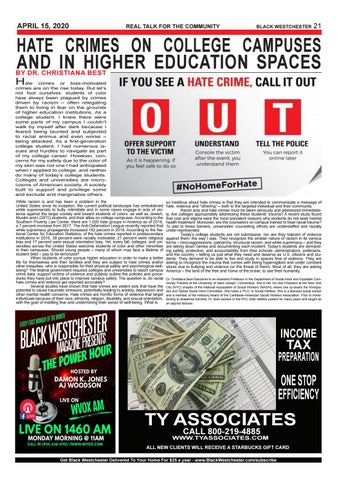APRIL 15, 2020
REAL TALK FOR THE COMMUNITY
BLACK WESTCHESTER
21
HATE CRIMES ON COLLEGE CAMPUSES AND IN HIGHER EDUCATION SPACES
BY DR. CHRISTIANA BEST
H ate crimes or bias-motivated crimes are on the rise today. But let’s
not fool ourselves: students of color have always been plagued by crimes driven by racism – often relegating them to living in fear on the grounds of higher education institutions. As a college student, I knew there were some parts of my campus I couldn’t walk by myself after dark because I feared being taunted and subjected to racial animus and even worse – being attacked. As a first-generation college student, I had numerous issues and hurdles to navigate as part of my college career. However, concerns for my safety due to the color of my skin was not one I had anticipated when I applied to college, and neither do many of today’s college students. Colleges and universities are microcosms of American society. A society built to support and privilege some and exclude and marginalize others. While racism is and has been a problem in the United States since its inception, the current political landscape has emboldened white supremacists to bully, intimidate and in some cases engage in acts of violence against the larger society and toward students of colors, as well as Jewish, Muslim and LGBTQ students, and their allies on college campuses. According to the Southern Poverty Law Center, there are 1,020 hate groups in America as of 2018, a 7 percent increase from 2017. The Anti-Defamation League recently reported that white supremacy propaganda increased 182 percent in 2018. According to the National Center for Education Statistics, of the hate crimes reported in postsecondary institutions in 2016, 38 percent were racially motivated; 21 percent were religious bias and 17 percent were sexual orientation bias. Yet, every fall, colleges, and universities across the United States welcome students of color and other minorities to their campuses. Should young people – many of whom may face a lifetime of student debt – pay to be terrorized? When students of color pursue higher education in order to make a better life for themselves and their families and they are subject to hate crimes and/or other inequities, who is responsible for their physical safety and psychological wellbeing? The federal government requires colleges and universities to report campus crime data, support victims of violence and publicly outline the policies and procedures they have put into place to improve campus safety. The question is, do racial hate crimes and violence get reported accurately? Several studies have shown that hate crimes are violent acts that have the potential to cause traumatic stressors, potentially leading to anxiety, depression and other mental health concerns. Hate crimes are horrific forms of violence that target individuals because of their race, ethnicity, religion, disability, and sexual orientation, with the goal of instilling fear and undermining their sense of well-being. What is
so insidious about hate crimes is that they are intended to communicate a message of hate, violence and “othering” – both to the targeted individual and their community. Racist acts and hate crimes must be taken seriously and addressed immediately. Are colleges appropriately addressing these students’ trauma? A recent study found that cost and stigma were the most prevalent reasons why students do not seek mental health treatment. Moreover, are the counselors on campus trained to treat racial trauma? To add to these barriers, universities’ counseling offices are understaffed and racially under-represented. Today’s college students are not submissive, nor are they tolerant of violence against them, the way I was. They recognize the sinister nature of racism in its various forms – microaggressions, patriarchy, structural racism, and white supremacy – and they are taking down names and documenting each incident. Today’s students are demanding safety, protection, and accountability from their schools, administrators, politicians, and the country – telling us just what they need and deserve as U.S. citizens and students. They demand to be able to live and study in spaces free of violence. They are asking to recognize the trauma that comes with being hypervigilant and under constant stress due to bullying and violence (or the threat of them). Most of all, they are asking America – the land of the free and home of the brave, to see their humanity. Dr. Christiana Best-Giacomini is an Assistant Professor in the Department of Social Work and Equitable Community Practice at the University of Saint Joseph, Connecticut. She is the 1st Vice President at the New York City (NYC) chapter of the National Association of Social Workers (NASW), where she co-chairs the Immigration and Global Social Work Committee. She holds a Ph.D. in Social Welfare. She is a licensed social worker and a member of the Advisory Board of the Caribbean-American Social Workers Association. Prior to transitioning to academia full-time, Dr. Best worked in the NYC child welfare system for many years and taught as an adjunct lecturer.
INCOME
TAX
PREPARATION
ONE STOP EFFICIENCY
TY ASSOCIATES CALL 800-219-4885
WWW.TYASSOCIATES.COM ALL NEW CLIENTS WILL RECEIVE A STARBUCKS GIFT CARD Get Black Westchester Delivered To Your Home For $25 a year - www.BlackWestchester.com/subscribe
